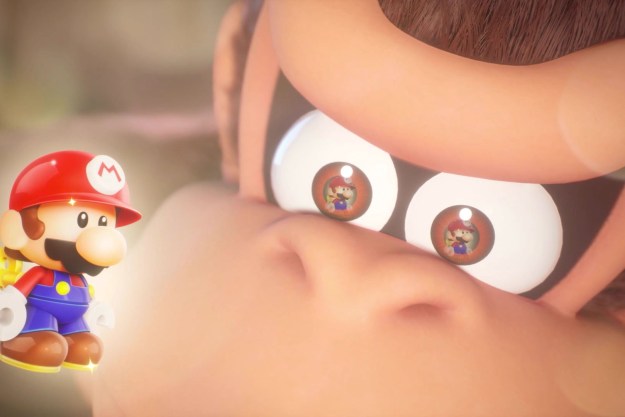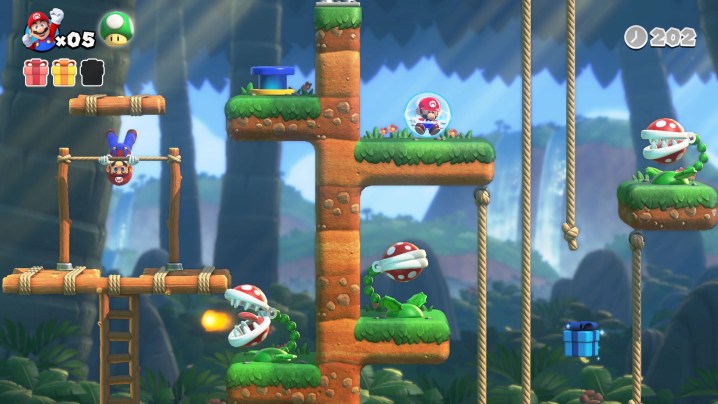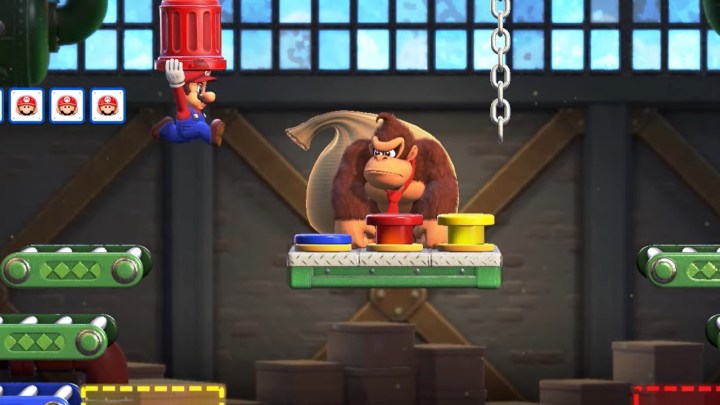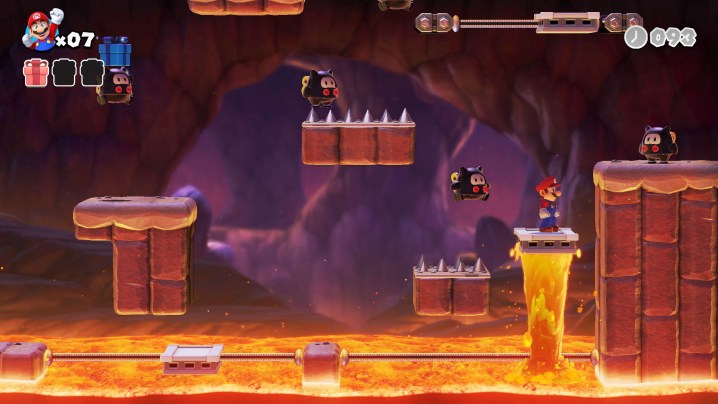
“Mario vs. Donkey Kong is a fun, if unremarkable way to kill time while you wait for the Nintendo Switch 2.”
- Faithfully remade
- Lots of new levels
- Excellent music
- Puzzles get repetitive
- Challenge lacking
- Rigid movement
With Mario vs. Donkey Kong, the video game industry’s current remake craze has reached a tipping point. We’re no longer just seeing foundational classics modernized to maintain their historical impact; everything is on the table, so long as it can help plug holes in a publisher’s product release schedule.
I suppose that’s how you end up with a left-field remake of a niche Game Boy Advance puzzle game during the final days of the Nintendo Switch’s life. It’s not that 2004’s Mario vs. Donkey Kong isn’t worthy of a revisit; in fact, I’m happy to see Nintendo give some love to a creative puzzler in an age where big publishers have all but abandoned the genre. It’s just hard to shake the feeling that the perfectly fine remake is less of a passion project and more of a business necessity to keep Switch games coming while Nintendo’s major studios cook up the Switch 2’s main attractions.
For those who harbor warm nostalgia for the Game Boy Advance era, Mario vs. Donkey Kong is a fun and faithful remake with some solid new puzzles and an unexpectedly terrific soundtrack. It’s an odd choice for a revisit, though, as the first-draft puzzles and rigid movement of the original release poke through the Switch version’s modern façade. It’s less of an exciting new Switch game and more like something light to hold Nintendo fans over while they wait for a shiny new console.
Square one
While the Mario vs. Donkey Kong series never rose to the heights of spinoff franchises like Mario Kart, there was a 12-year period where Nintendo was all-in on the series. Seven entries launched within that time frame, spanning the Game Boy Advance to the Wii U. It would be tempting to label it a “dead series” in need of a reboot due to its eight-year absence, but that would be a premature diagnosis. It hasn’t skipped multiple console generations, unlike other Nintendo series. That’s what makes the newly remade Mario vs. Donkey Kong such an odd project from the jump: This isn’t something that needed to go back to square one.
Mario vs. Donkey Kong works better as an approachable, kid-friendly puzzler that anyone can pick up.
That’s exactly the approach Nintendo took here, however, as the Switch version is a nearly 1:1 recreation of the Game Boy Advance original. The core gameplay loop hasn’t changed. Mario jumps into bite-sized levels that blend traditional 2D platforming and puzzle solving. The goal is to grab a key, get it back to a door, and rescue a mini Mario figurine. Along the way, players will need to avoid toy-like enemies, hit colored switches to alter the level’s obstacles, and do a bit of jumping to complete objectives in an “order of operations” manner. It’s still a clever concept that recontextualizes Mario’s standard platforming toolset into puzzle-solving tools.
There is perhaps a reason, though, why puzzle games like this aren’t often tapped for remakes. It’s a genre fueled by iteration. The first entry in a new series tends to act as a stable foundation that developers can expand on with more complex ideas in later installments. I can feel that when coming at Mario vs. Donkey Kong as an entirely modern release instead of in its GBA form. The puzzles (and simple boss stages) often feel like they’re building the basics of the format. Very few of its original levels, including those in bonus worlds, pose much of a mental challenge. For the most part, I was able to blow through them with ample time to spare, while nabbing the three collectible gifts in each stage. Even with a wealth of gimmicks that play with the formula, like stages that have me directing an army of mini Marios around conveyor belts, the elementary nature of it can feel repetitive and boring due to a lack of brain-busters.

The only challenges I faced were inadvertent ones. Despite looking like a modern Switch game, the remake still controls like a GBA title made with a D-pad in mind. Movement is stiff, with short jumps and a reliance on maneuvers like backflips that are a pain to execute consistently. That issue becomes especially clear in the package’s 12 Expert stages, some of which rely on precise control and timing. Most of my deaths throughout the 130 levels came from misjudged jumps, rather than the clock running out as I struggled to cook up the right solution.
The development team seems aware of how frustrating that reliance on perfect execution in an imperfect game can be. It’s clear that the remake has young players in mind. That’s reinforced by a few additions in the remake, including co-op play that’s perfect for parents and a Casual mode that’s far more forgiving. While it won’t challenge older players much, Mario vs. Donkey Kong works better as an approachable, kid-friendly puzzler that anyone can pick up. Maybe that’s the only innovation that really matters here.
More puzzles
The best news for series’ fans here is that the remake includes two entirely new worlds (as well as “plus” versions of them, which add another suite of stages for each). That brings the number of levels in the game up to around 130, which is a sizable increase over the original. That helps pad out the relatively short original game, as players will likely take 12 to 15 hours to get every star.

The new stages are a mixed bag, but they’re welcome additions nonetheless. The new Merry Mini-Land might just be the best world in the entire suite thanks to creative new puzzle gimmicks like flower vents and teleportation boxes. Slippery Summit, on the other hand, is on the weaker end of the spectrum. Its levels have players sliding around on ice, which makes an already cumbersome physics system even harder to master. It does contain some clever ideas though, as I need to slide objects under low blocks and chase after them.
The only thing that feels like a missed opportunity here is that the package doesn’t include any of the original’s lost levels, which have an odd history. The game originally supported Nintendo’s e-Reader peripheral. Players could scan cards to unlock two additional levels. However, only five of those cards were seemingly released, and the functionality was cut from the European version of the game entirely. The remake had an opportunity to save those from becoming lost media, making the Switch version the definitive edition. It’s a slight missed opportunity, but one that doesn’t take away from the package.
Time Attack technically doubles the potential runtime for completionists, but through forced repetition.
One small change that does feel like a slight step back is the remake’s approach to high scores. In the original version, players got points when completing each level based on how long it took to complete them. That added some arcade-style charm to it, giving fans something to compete over. Nintendo cuts that feature here and replaces it with an unlockable Time Attack mode that’s more straightforward as players try to clear levels in a very limited time. While it’s functionally the same idea as the original, it has to be unlocked by fully beating the game (players must also beat all Plus worlds to unlock Time Attack on those bonus stages). I was 10 hours deep before I got full access to Time Attack, and the idea of repeating every single level again just to set my first score felt like a chore.
I can’t help but wonder if that small change was an attempt to squeeze more replay value out of a short game repackaged with a hefty $50 price tag. Time Attack technically doubles the potential runtime for completionists, but through forced repetition. It all leads me back to my feeling that the project’s main function is to help fill a potential software drought on the road to the Switch 2.
New look, old audio
Though the core game isn’t quite as exciting as it was in 2004, the development team gives it a respectable remake treatment. A modern visual refresh makes it look even more like a kid’s cartoon, as do its fully animated cutscenes. Both of those touches bring it more in line with the unified vision of the series we saw last year with games like Super Mario Bros. Wonder and Super Mario RPG. It very much looks like it’s in the same universe as those titles with its vibrant colors and happy-go-lucky attitude.
It’s a bit of harmless padding that will please a certain subset of nostalgic fans.
Nintendo also continues its hot streak of superbly rearranged music. If nothing else, Mario vs. Donkey Kong will be remembered for having one of the best musical scores in a Mario game. It’s a jazzy collection of tracks complete with lively percussion and silky smooth saxophone.
Less impressive on the audio front is its seemingly recycled voice work. Charles Martinet, who retired from voicing the character last year, is curiously credited as a member of the voice cast. The character’s new voice actor, Kevin Afghani, is nowhere to be found. It seems as though the remake simply pulled in some old Martinet voice lines instead of recording new ones. They aren’t from the original Game Boy Advance title either; Mario is notably less talkative in the remake.

It’s not a deal breaker by any means, but it does lend to the feeling that the release perhaps wasn’t a very high-priority project for Nintendo. As was the case with last year’s Super Mario RPG, I get the feeling that this is strictly business for Nintendo; it’s a pure product. As I play through it, I flash back to the final years of the 3DS, where Nintendo insisted it would keep supporting the product despite moving on to Switch. Those few years were filled with random ports like Luigi’s Mansion and scattershot remakes. It was a sign that Nintendo felt it had to make good on a promise to dedicated players without pulling away too many resources from high-value Switch titles.
With Mario vs. Donkey Kong, the Switch seems to have reached that same point. Otherwise, I’d imagine we’d be looking at a totally new installment here. It’s a bit of harmless padding that will please a certain subset of nostalgic fans, while making sure February doesn’t go by without a new first-party game. Switch owners can safely ignore it if they want, but they’re going to have some time to kill as the wait for the next big Nintendo console continues. You could do a lot worse than a light and breezy puzzle package that’ll eat up 20 hours of downtime.
Mario vs. Donkey Kong was tested on a Nintendo Switch OLED in handheld mode and on a TCL 6-Series R635 when docked.



